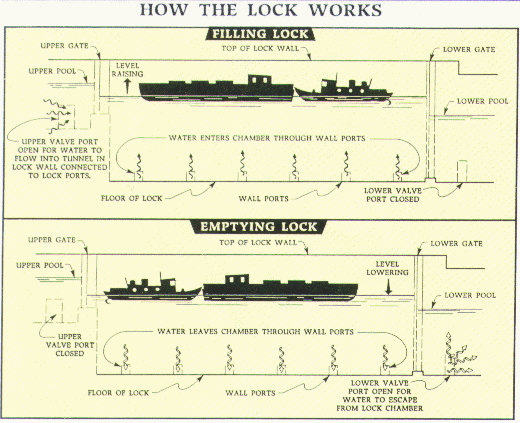Erie Canal Bike Tour
Rachmiel Langer
How a Lock Works
Canal locks are water elevators that lift or lower boats from one level
of a river to another.
Water flows into and out of the lock chamber by the force of gravity
or in other words, by the pressure of the high level of water and not by
pumps. This flow of water is controlled by valves at both the upper
and lower end of the lock chamber.
For Boats Heading Up River
With the water in the lock chamber at the same level as the lower pool,
with all the valves closed, the lock operator opens the lower gates to
allow a boat from the lower pool to enter the lock chamber. The lower lock
gates are then closed, confining the boat within the lock chamber.
The upper valves are then opened. This permits water to flow from the
upper pool into the lock chamber. Since the lower valves and lower lock
gates are closed, the incoming water cannot escape from the lock chamber.
Water seeks its own level, so the water flowing into the lock chamber rises
until it reaches the same level as water in the upper pool. Naturally,
the rising water lifts the boat to the higher elevation.
With the water level in the lock chamber now the same as in the upper pool,
the upper lock gates are opened to allow the boat to exit the lock chamber
into the upper pool.
For Boats Heading Down River
A boat in the upper pool enters the lock chamber. The upper lock gates
are closed, confining the boat within the lock chamber. The upper valves
are then closed and the lower valves are opened, permitting water to flow
out of the lock chamber into the lower pool. As the water in the lock chamber
drops to the same level as the water in the lower pool, the boat is lowered.
With the water in the lock chamber now at the same level as the lower
pool, the lower lock gates are opened to allow the boat to exit the lock
chamber into the lower pool.
The diagram and text are from the pamphlet,
Lockport New York, Historic Jewel of the Erie Canal.
 Previous
Home
Previous
Home
